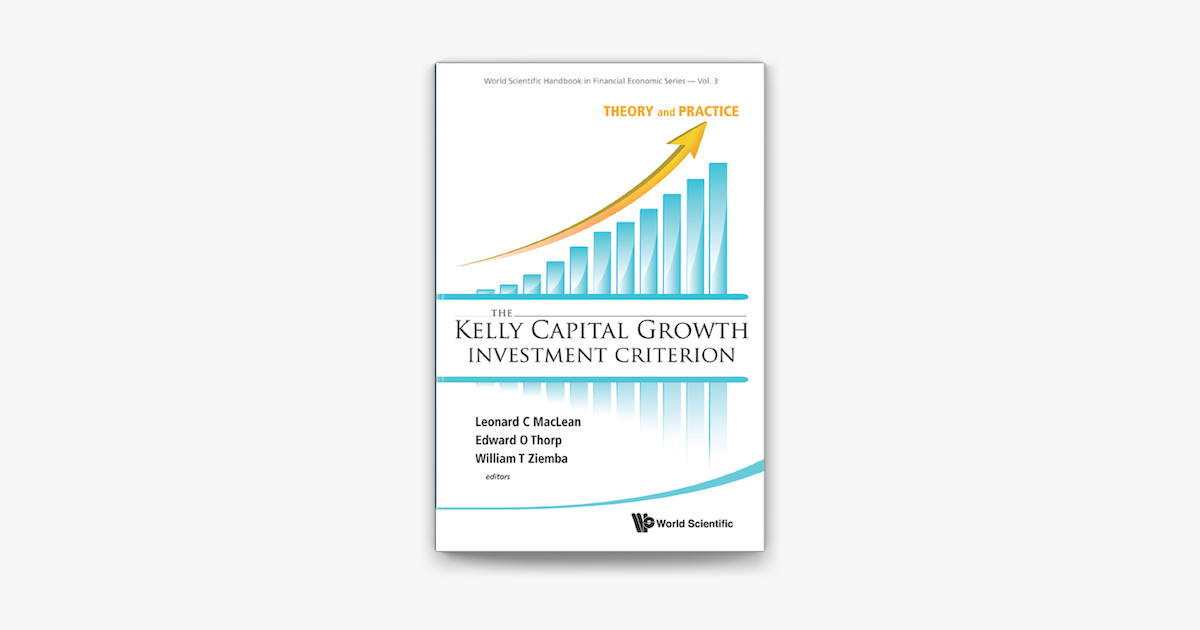Kelly Growth Criterion
Review The Kelly Capital Growth Investment Criterion: Theory and Practice
- Kelly Capital Growth Investment Criterion
- Kelly Capital Growth Investment Criterion Pdf
- Kelly Growth Criterion Definition
- Kelly Growth Criterion Theory
by LEONARD C. MACLEAN, EDWARD O. THORP, WILLIAM T. ZIEMBA
Description
References 1 Thorp, E. The Kelly criterion in blackjack sports betting, and the stock market. In The Kelly Capital Growth Investment Criterion: Theory and Practice (pp. The main advantage of the Kelly criterion, which maximizes the expected value of the logarithm of wealth period by period, is that it maximizes the limiting exponential growth rate of wealth. The main disadvantage of the Kelly criterion is that its suggested wagers may be very large. Hence, the Kelly criterion can be very risky in the short term. Introduction to the Kelly Capital Growth Alumni Professor Sauder School of Business University of British Columbia Investment Strategies 49 ell o y Criterion and Samuelson’s Objections to it The Kelly capital growth criterion, which maximizes the expected log of final.
This book contains the definitive treatment of fortune’s formula, also known as the Kelly capital growth criterion. This strategy aims to amplify long-run wealth by maximizing period by the period expected utility with a logarithmic utility function. Generally, the strategy can be risky when used short-term, but when the number of bets is increased, the bettor’s wealth can be bigger in comparison to using other strategies.
We develop a general framework to apply the Kelly criterion to the stock market data, and consequently, to portfolio optimization. Under few conditions, using Monte Carlo simulations with different scenarios we prove that the Kelly criterion beats any other approach in many aspects. In particular, it maximizes the expected growth rate and the median of the terminal wealth. The Kelly criterion is maximally aggressive — it seeks to increase capital at the maximum rate possible. Professional gamblers typically take a less aggressive approach, and generally will not bet more than about 2.5% of their bankroll on any wager. In this case that would be $25.00.
This book is encouraged to graduate and postdoctoral students, academics, and researchers. Aside from that, it is also recommended to professional traders interested in betting strategies. With that in mind, the book has many jargons and technical concepts that would need prior knowledge in order to be understood. This book is not for the common readers, though the book already indicates that.
On the good side, this book expounds on the strategy Kelly Criterion as it is applied to investing. The book is divided into six parts and subdivided into chapters, allowing the reader to pick a particular topic they want. Many chapters are discussing various topics, which assures that the Kelly Criterion is discussed here very well.
About the Author
LEONARD C. MACLEAN is Professor Emeritus of Rowe School of Business at Dalhousie University. He has written various publications and has been awarded the Rowe Business School Researcher of the Year Award in 2014. He received his MA and Ph.D. from Dalhousie University.
EDWARD O. THORP is most popular in the finance industry in his book Beat the Dealer, published in 1962. It was the first book to prove that blackjack can be beaten through card counting mathematically. He is regarded as among the best hedge fund managers globally.

WILLIAM T. ZIEMBA is Alumni Professor of Financial Modeling and Stochastic Optimization and Professor Emeritus of the Sauder School of Business at the University of British Columbia from 1968-2004. He earned his Ph.D. from the University of California, Berkeley.
Table of Contents
Preface
List of Contributors
Acknowledgments
Pictures
Kelly Capital Growth Investment Criterion
Part I: The Early Ideas and Contributions
Part II: Classic Papers and Theories
Part III: The Relationship of Kelly Optimization to Asset Allocation
Part IV: Critics and Assessing the Good and Bad Properties of Kelly
Part V: Utility Foundations
Kelly Capital Growth Investment Criterion Pdf

Part VI: Evidence of the Use of Kelly Type Strategies by the Great Investors and Others
Bibliography
Kelly Growth Criterion Definition
Author Index
Kelly Growth Criterion Theory
Subject Index